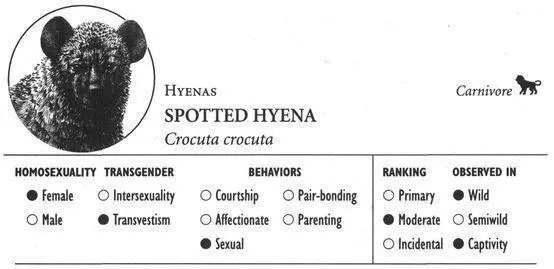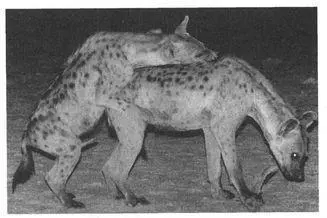Jonkel, C. J., and I. McT. Cowan (1971) “The Black Bear in the Spruce-Fir Forest.” Wildlife Monographs 27:1–57.
Rogers, L. (1976) “Effects of Mast and Berry Crop Failures on Survival, Growth, and Reproductive Success of Black Bears.” Transactions of the North American Wildlife and Natural Resources Conference 41:431–38.
Schenk, A., and K. M. Kovacs (1995) “Multiple Mating Between Black Bears Revealed by DNA Fingerprinting.” Animal Behavior 50:1483–90.
Stonorov, D., and A. W. Stokes (1972) “Social Behavior of the Alaska Brown Bear.” In S. Herrero, ed., Bears— Their Biology and Management: Papers from the Second International Conference on Bear Research and Management, pp. 232-42. Morges, Switzerland: International Union for Conservation of Nature and Natural Resources.
Tait, D. E. N. (1980) “Abandonment as a Reproductive Tactic—the Example of Grizzly Bears.” American Naturalist 115:800–808.
Wimsatt, W. A. (1969) “Delayed Implantation in the Ursidae, with Particular Reference to the Black Bear (Ursus americanus Pallus).” In A. C. Enders, ed., Delayed Implantation, pp. 49–76. Chicago: University of Chicago Press.

IDENTIFICATION: A yellowish brown hyena with spotted flanks and back, a strongly sloping body profile, and rounded ears; females typically heavier than males. DISTRIBUTION: Sub-Saharan Africa. HABITAT: Open country, including plains, semidesert, savanna. STUDY AREAS: Kalahari and Gemsbok National Parks, South Africa and Botswana; University of California–Berkeley.
Social Organization
Spotted Hyenas live in matrilineal clans of 30–80 individuals. Females are dominant to males and remain in their home group for life, while males emigrate to single-sex groups during adolescence and then join other clans (usually for only a few years at a time) on reaching adulthood. This species has a highly organized social system, engaging in cooperative hunting and communal denning. The breeding system is polygynous: generally only one male in each clan mates with several females. Spotted Hyenas are largely nocturnal.
Description
Behavioral Expression: Female Spotted Hyenas have an extraordinary genital configuration that makes them superficially resemble males: the clitoris is 90 percent of the length of the male’s penis (nearly seven inches long) and equal to it in diameter; it can be fully erected. In addition, the labia are fused to resemble a “scrotum” containing fat and connective tissue that give the appearance of testes. There is no vaginal opening—instead, the female mates and gives birth (as well as urinates) through the tip of her clitoris. Heterosexual mating is accomplished by retracting the clitoris inside the abdomen, essentially turning it inside out to form a passageway within which the male can insert his penis. Homosexual mounting between females also occurs in this species; in some cases, an adolescent or younger adult mounts an older one. During a homosexual encounter, one female approaches another with her clitoris erect, often “flipping” it up against her abdomen as a sign of sexual arousal (also seen in males preparing to mate). She may lick her partner on the back, then mount by rising up and clasping her front paws around the other female, resting her head on the other’s neck, and thrusting against her. Clitoral penetration may also occur, though it is not common. Sometimes the female being mounted appears to be disinterested or nonchalant and may even wander off during mounting. These are also characteristics of heterosexual courtship and copulation—females often walk away or do not permit males to achieve penetration and, indeed, may be overtly aggressive toward them. Spotted Hyenas also perform a MEETING CEREMONY involving clitoral erection and genital licking: two females stand parallel to each other but with their heads in opposite directions so that they can access each other’s genitals. One or both of them lifts up her hind leg and allows the other to sniff, nuzzle, and lick her erect clitoris and “scrotum”—sometimes for as long as half a minute at a time—occasionally accompanied by a soft groaning or whining sound. Although meeting ceremonies are sometimes performed between males and females (or between two males), they are most common between females.
A younger female Spotted Hyena (with erect clitoris) mounting an older female in southern Africa.

Two female Spotted Hyenas nuzzling and sniffing each other’s genitals during the “meeting ceremony”; note the erect clitoris and “scrotum” of the female raising her leg.

Frequency: All adult female Spotted Hyenas have enlarged clitorides and labial “scrota.” Homosexual mounting probably occurs only occasionally in this species, although the majority of meeting ceremonies—anywhere from 55–95 percent—occur between adult females.
Orientation: Most females who participate in same-sex mounting and meeting ceremonies are probably functionally bisexual (if not predominantly heterosexual), also mating with males.
Nonreproductive and Alternative Heterosexualities
The female Spotted Hyena’s reproductive anatomy and genitals are not optimal for breeding. Heterosexual mating is often difficult, as males have trouble locating and penetrating the clitoral opening. In addition, many females (and infants) suffer severe trauma and even death during the birth process. Because there is no vaginal canal, Hyenas must give birth through the clitoris itself—an extraordinarily painful process, considering that the newborn’s head is significantly larger than the diameter of the clitoris. This causes the clitoral head to rupture in all females during their first birth, and it is estimated that about 9 percent of females in the wild die during their first labor. In addition, the newborn must travel an extraordinarily long way through the female’s birth canal, which makes a 180-degree turn to exit through the clitoris. Because the umbilical cord is less than a third of the length of the birth canal, many babies suffocate during birth—perhaps as many as 60 percent of infants are stillborn to first-time mothers, and a female’s lifetime production of offspring may be reduced by as much as 25 percent because of such complications. Once born, up to a quarter of Spotted Hyena youngsters may be killed by their siblings, who are fiercely competitive and aggressive toward one another. Infanticide (usually by females) also occasionally occurs among Spotted Hyenas, and cannibalism has been reported as well. Most males do not breed at all: the social system of Spotted Hyenas is such that only one male in a clan gets to mate with the females (although other males may participate in heterosexual courtship). Some males, unable to copulate, engage in a form of “masturbation” in which they thrust their penis in the air and spontaneously ejaculate; others have been seen mounting cubs.
Other Species
Homosexual mounting occurs in Dwarf Mongooses (Helogale undulata), a weasel-like carnivore of Africa. In one group studied in captivity, 16 percent of mounting took place between animals of the same sex (mostly males, including brothers), and some individuals had preferred partners with whom they interacted most frequently. Homosexual behavior has also been observed in two other species of small carnivores: male Common Raccoons (Procyon lotor) and female Martens (Martes sp.).
Читать дальше















